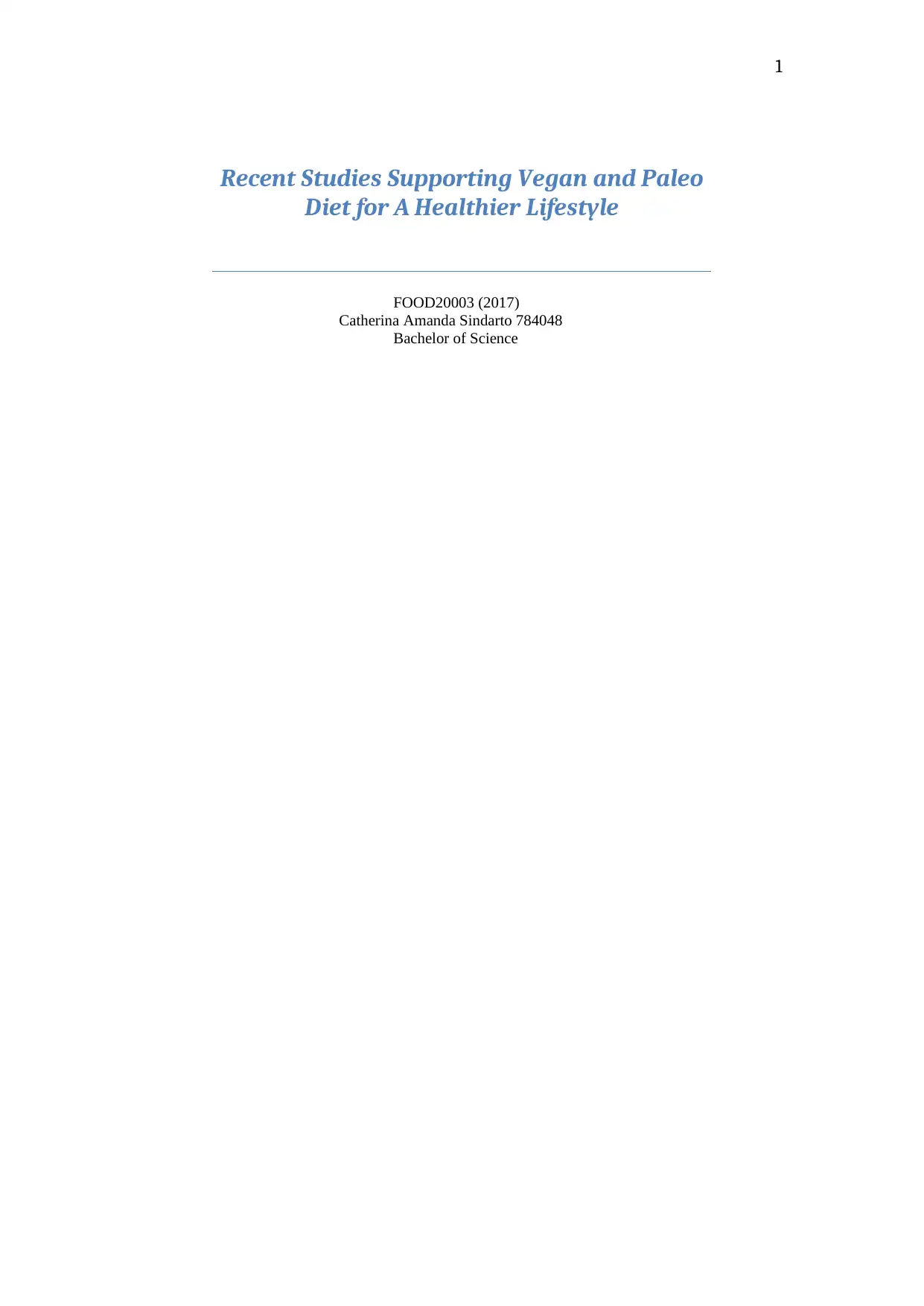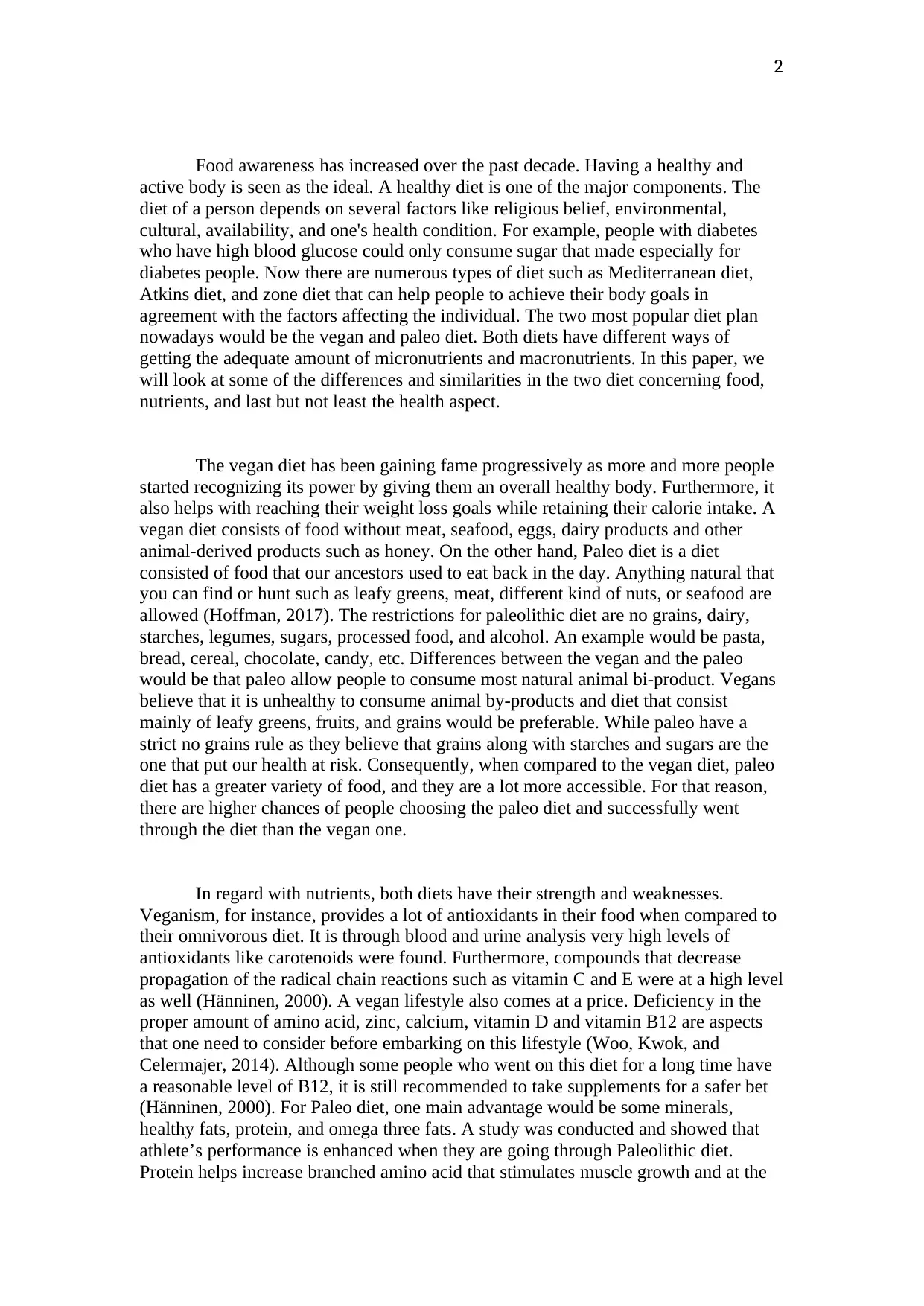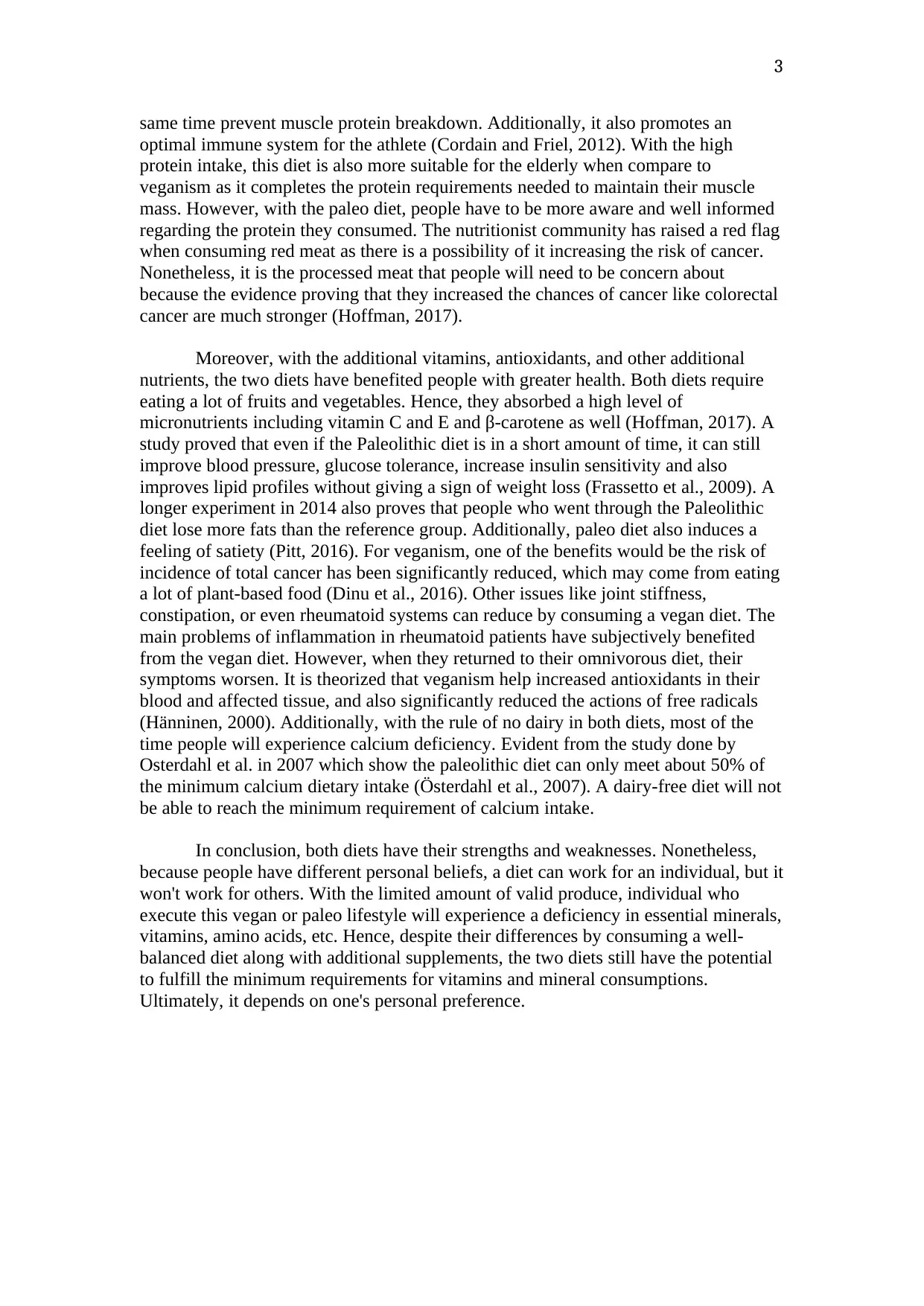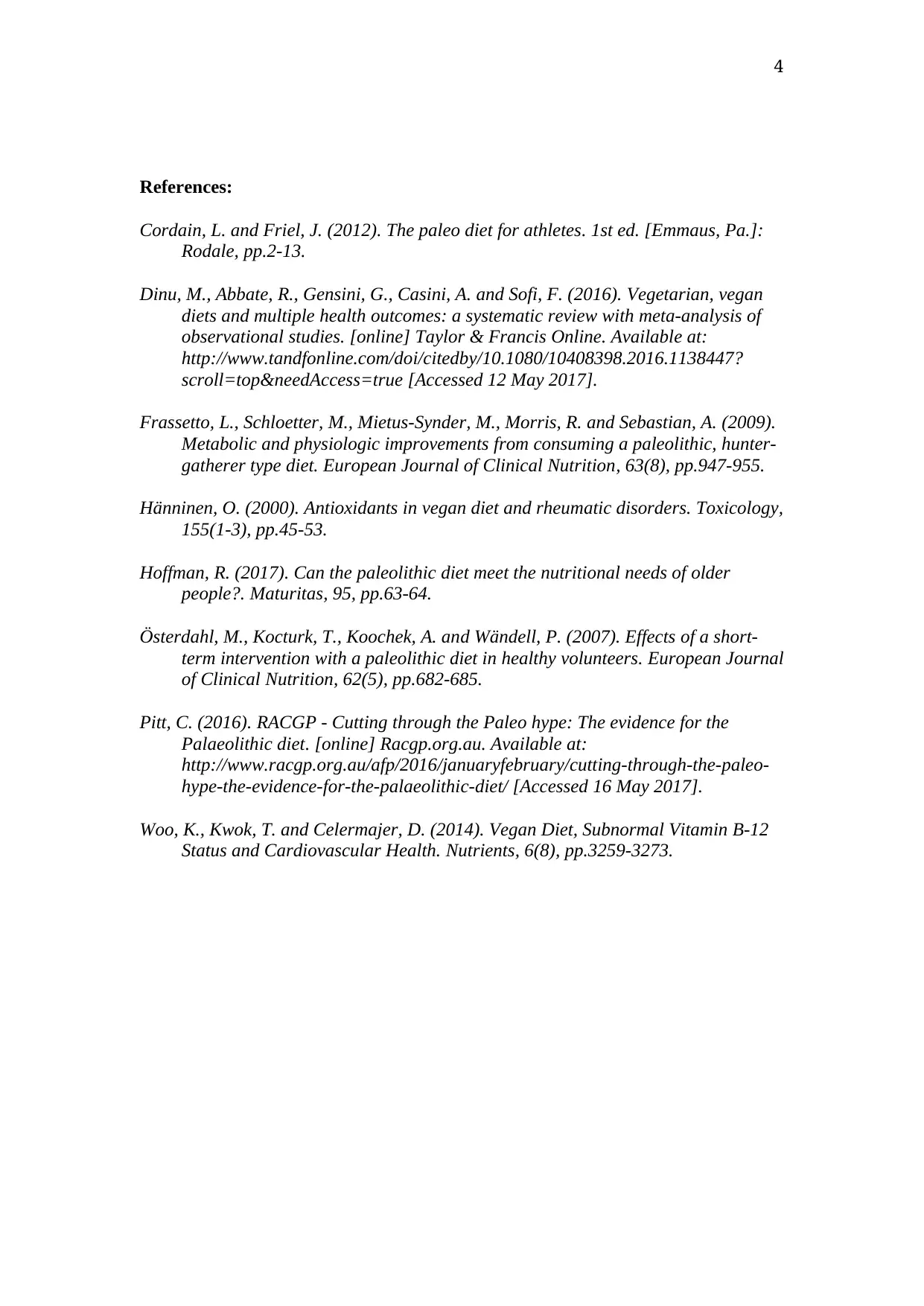FOOD20003: Paleo and Vegan Diets - A Detailed Health Comparison
VerifiedAdded on 2023/06/11
|4
|1624
|99
Essay
AI Summary
This essay provides a comparative analysis of the Paleo and Vegan diets, examining their respective food choices, nutrient profiles, and health implications. The vegan diet excludes all animal products, emphasizing plant-based foods, while the Paleo diet focuses on foods presumed to have been eaten by early humans, such as meat, seafood, fruits, and vegetables, while excluding grains, legumes, and processed foods. The essay discusses the strengths and weaknesses of each diet in terms of nutrient intake, highlighting potential deficiencies and benefits. It also explores the impact of both diets on various health markers, including antioxidant levels, cardiovascular health, and cancer risk. Ultimately, the essay concludes that while both diets have potential health benefits, individual preferences and careful planning are essential to ensure adequate nutrient intake and overall well-being. Desklib offers a wealth of resources, including past papers and solved assignments, to support students in their academic endeavors.

Recent Studies Supporting Vegan and Paleo
Diet for A Healthier Lifestyle
FOOD20003 (2017)
Catherina Amanda Sindarto 784048
Bachelor of Science
1
Diet for A Healthier Lifestyle
FOOD20003 (2017)
Catherina Amanda Sindarto 784048
Bachelor of Science
1
Paraphrase This Document
Need a fresh take? Get an instant paraphrase of this document with our AI Paraphraser

Food awareness has increased over the past decade. Having a healthy and
active body is seen as the ideal. A healthy diet is one of the major components. The
diet of a person depends on several factors like religious belief, environmental,
cultural, availability, and one's health condition. For example, people with diabetes
who have high blood glucose could only consume sugar that made especially for
diabetes people. Now there are numerous types of diet such as Mediterranean diet,
Atkins diet, and zone diet that can help people to achieve their body goals in
agreement with the factors affecting the individual. The two most popular diet plan
nowadays would be the vegan and paleo diet. Both diets have different ways of
getting the adequate amount of micronutrients and macronutrients. In this paper, we
will look at some of the differences and similarities in the two diet concerning food,
nutrients, and last but not least the health aspect.
The vegan diet has been gaining fame progressively as more and more people
started recognizing its power by giving them an overall healthy body. Furthermore, it
also helps with reaching their weight loss goals while retaining their calorie intake. A
vegan diet consists of food without meat, seafood, eggs, dairy products and other
animal-derived products such as honey. On the other hand, Paleo diet is a diet
consisted of food that our ancestors used to eat back in the day. Anything natural that
you can find or hunt such as leafy greens, meat, different kind of nuts, or seafood are
allowed (Hoffman, 2017). The restrictions for paleolithic diet are no grains, dairy,
starches, legumes, sugars, processed food, and alcohol. An example would be pasta,
bread, cereal, chocolate, candy, etc. Differences between the vegan and the paleo
would be that paleo allow people to consume most natural animal bi-product. Vegans
believe that it is unhealthy to consume animal by-products and diet that consist
mainly of leafy greens, fruits, and grains would be preferable. While paleo have a
strict no grains rule as they believe that grains along with starches and sugars are the
one that put our health at risk. Consequently, when compared to the vegan diet, paleo
diet has a greater variety of food, and they are a lot more accessible. For that reason,
there are higher chances of people choosing the paleo diet and successfully went
through the diet than the vegan one.
In regard with nutrients, both diets have their strength and weaknesses.
Veganism, for instance, provides a lot of antioxidants in their food when compared to
their omnivorous diet. It is through blood and urine analysis very high levels of
antioxidants like carotenoids were found. Furthermore, compounds that decrease
propagation of the radical chain reactions such as vitamin C and E were at a high level
as well (Hänninen, 2000). A vegan lifestyle also comes at a price. Deficiency in the
proper amount of amino acid, zinc, calcium, vitamin D and vitamin B12 are aspects
that one need to consider before embarking on this lifestyle (Woo, Kwok, and
Celermajer, 2014). Although some people who went on this diet for a long time have
a reasonable level of B12, it is still recommended to take supplements for a safer bet
(Hänninen, 2000). For Paleo diet, one main advantage would be some minerals,
healthy fats, protein, and omega three fats. A study was conducted and showed that
athlete’s performance is enhanced when they are going through Paleolithic diet.
Protein helps increase branched amino acid that stimulates muscle growth and at the
2
active body is seen as the ideal. A healthy diet is one of the major components. The
diet of a person depends on several factors like religious belief, environmental,
cultural, availability, and one's health condition. For example, people with diabetes
who have high blood glucose could only consume sugar that made especially for
diabetes people. Now there are numerous types of diet such as Mediterranean diet,
Atkins diet, and zone diet that can help people to achieve their body goals in
agreement with the factors affecting the individual. The two most popular diet plan
nowadays would be the vegan and paleo diet. Both diets have different ways of
getting the adequate amount of micronutrients and macronutrients. In this paper, we
will look at some of the differences and similarities in the two diet concerning food,
nutrients, and last but not least the health aspect.
The vegan diet has been gaining fame progressively as more and more people
started recognizing its power by giving them an overall healthy body. Furthermore, it
also helps with reaching their weight loss goals while retaining their calorie intake. A
vegan diet consists of food without meat, seafood, eggs, dairy products and other
animal-derived products such as honey. On the other hand, Paleo diet is a diet
consisted of food that our ancestors used to eat back in the day. Anything natural that
you can find or hunt such as leafy greens, meat, different kind of nuts, or seafood are
allowed (Hoffman, 2017). The restrictions for paleolithic diet are no grains, dairy,
starches, legumes, sugars, processed food, and alcohol. An example would be pasta,
bread, cereal, chocolate, candy, etc. Differences between the vegan and the paleo
would be that paleo allow people to consume most natural animal bi-product. Vegans
believe that it is unhealthy to consume animal by-products and diet that consist
mainly of leafy greens, fruits, and grains would be preferable. While paleo have a
strict no grains rule as they believe that grains along with starches and sugars are the
one that put our health at risk. Consequently, when compared to the vegan diet, paleo
diet has a greater variety of food, and they are a lot more accessible. For that reason,
there are higher chances of people choosing the paleo diet and successfully went
through the diet than the vegan one.
In regard with nutrients, both diets have their strength and weaknesses.
Veganism, for instance, provides a lot of antioxidants in their food when compared to
their omnivorous diet. It is through blood and urine analysis very high levels of
antioxidants like carotenoids were found. Furthermore, compounds that decrease
propagation of the radical chain reactions such as vitamin C and E were at a high level
as well (Hänninen, 2000). A vegan lifestyle also comes at a price. Deficiency in the
proper amount of amino acid, zinc, calcium, vitamin D and vitamin B12 are aspects
that one need to consider before embarking on this lifestyle (Woo, Kwok, and
Celermajer, 2014). Although some people who went on this diet for a long time have
a reasonable level of B12, it is still recommended to take supplements for a safer bet
(Hänninen, 2000). For Paleo diet, one main advantage would be some minerals,
healthy fats, protein, and omega three fats. A study was conducted and showed that
athlete’s performance is enhanced when they are going through Paleolithic diet.
Protein helps increase branched amino acid that stimulates muscle growth and at the
2

same time prevent muscle protein breakdown. Additionally, it also promotes an
optimal immune system for the athlete (Cordain and Friel, 2012). With the high
protein intake, this diet is also more suitable for the elderly when compare to
veganism as it completes the protein requirements needed to maintain their muscle
mass. However, with the paleo diet, people have to be more aware and well informed
regarding the protein they consumed. The nutritionist community has raised a red flag
when consuming red meat as there is a possibility of it increasing the risk of cancer.
Nonetheless, it is the processed meat that people will need to be concern about
because the evidence proving that they increased the chances of cancer like colorectal
cancer are much stronger (Hoffman, 2017).
Moreover, with the additional vitamins, antioxidants, and other additional
nutrients, the two diets have benefited people with greater health. Both diets require
eating a lot of fruits and vegetables. Hence, they absorbed a high level of
micronutrients including vitamin C and E and β-carotene as well (Hoffman, 2017). A
study proved that even if the Paleolithic diet is in a short amount of time, it can still
improve blood pressure, glucose tolerance, increase insulin sensitivity and also
improves lipid profiles without giving a sign of weight loss (Frassetto et al., 2009). A
longer experiment in 2014 also proves that people who went through the Paleolithic
diet lose more fats than the reference group. Additionally, paleo diet also induces a
feeling of satiety (Pitt, 2016). For veganism, one of the benefits would be the risk of
incidence of total cancer has been significantly reduced, which may come from eating
a lot of plant-based food (Dinu et al., 2016). Other issues like joint stiffness,
constipation, or even rheumatoid systems can reduce by consuming a vegan diet. The
main problems of inflammation in rheumatoid patients have subjectively benefited
from the vegan diet. However, when they returned to their omnivorous diet, their
symptoms worsen. It is theorized that veganism help increased antioxidants in their
blood and affected tissue, and also significantly reduced the actions of free radicals
(Hänninen, 2000). Additionally, with the rule of no dairy in both diets, most of the
time people will experience calcium deficiency. Evident from the study done by
Osterdahl et al. in 2007 which show the paleolithic diet can only meet about 50% of
the minimum calcium dietary intake (Österdahl et al., 2007). A dairy-free diet will not
be able to reach the minimum requirement of calcium intake.
In conclusion, both diets have their strengths and weaknesses. Nonetheless,
because people have different personal beliefs, a diet can work for an individual, but it
won't work for others. With the limited amount of valid produce, individual who
execute this vegan or paleo lifestyle will experience a deficiency in essential minerals,
vitamins, amino acids, etc. Hence, despite their differences by consuming a well-
balanced diet along with additional supplements, the two diets still have the potential
to fulfill the minimum requirements for vitamins and mineral consumptions.
Ultimately, it depends on one's personal preference.
3
optimal immune system for the athlete (Cordain and Friel, 2012). With the high
protein intake, this diet is also more suitable for the elderly when compare to
veganism as it completes the protein requirements needed to maintain their muscle
mass. However, with the paleo diet, people have to be more aware and well informed
regarding the protein they consumed. The nutritionist community has raised a red flag
when consuming red meat as there is a possibility of it increasing the risk of cancer.
Nonetheless, it is the processed meat that people will need to be concern about
because the evidence proving that they increased the chances of cancer like colorectal
cancer are much stronger (Hoffman, 2017).
Moreover, with the additional vitamins, antioxidants, and other additional
nutrients, the two diets have benefited people with greater health. Both diets require
eating a lot of fruits and vegetables. Hence, they absorbed a high level of
micronutrients including vitamin C and E and β-carotene as well (Hoffman, 2017). A
study proved that even if the Paleolithic diet is in a short amount of time, it can still
improve blood pressure, glucose tolerance, increase insulin sensitivity and also
improves lipid profiles without giving a sign of weight loss (Frassetto et al., 2009). A
longer experiment in 2014 also proves that people who went through the Paleolithic
diet lose more fats than the reference group. Additionally, paleo diet also induces a
feeling of satiety (Pitt, 2016). For veganism, one of the benefits would be the risk of
incidence of total cancer has been significantly reduced, which may come from eating
a lot of plant-based food (Dinu et al., 2016). Other issues like joint stiffness,
constipation, or even rheumatoid systems can reduce by consuming a vegan diet. The
main problems of inflammation in rheumatoid patients have subjectively benefited
from the vegan diet. However, when they returned to their omnivorous diet, their
symptoms worsen. It is theorized that veganism help increased antioxidants in their
blood and affected tissue, and also significantly reduced the actions of free radicals
(Hänninen, 2000). Additionally, with the rule of no dairy in both diets, most of the
time people will experience calcium deficiency. Evident from the study done by
Osterdahl et al. in 2007 which show the paleolithic diet can only meet about 50% of
the minimum calcium dietary intake (Österdahl et al., 2007). A dairy-free diet will not
be able to reach the minimum requirement of calcium intake.
In conclusion, both diets have their strengths and weaknesses. Nonetheless,
because people have different personal beliefs, a diet can work for an individual, but it
won't work for others. With the limited amount of valid produce, individual who
execute this vegan or paleo lifestyle will experience a deficiency in essential minerals,
vitamins, amino acids, etc. Hence, despite their differences by consuming a well-
balanced diet along with additional supplements, the two diets still have the potential
to fulfill the minimum requirements for vitamins and mineral consumptions.
Ultimately, it depends on one's personal preference.
3
⊘ This is a preview!⊘
Do you want full access?
Subscribe today to unlock all pages.

Trusted by 1+ million students worldwide

References:
Cordain, L. and Friel, J. (2012). The paleo diet for athletes. 1st ed. [Emmaus, Pa.]:
Rodale, pp.2-13.
Dinu, M., Abbate, R., Gensini, G., Casini, A. and Sofi, F. (2016). Vegetarian, vegan
diets and multiple health outcomes: a systematic review with meta-analysis of
observational studies. [online] Taylor & Francis Online. Available at:
http://www.tandfonline.com/doi/citedby/10.1080/10408398.2016.1138447?
scroll=top&needAccess=true [Accessed 12 May 2017].
Frassetto, L., Schloetter, M., Mietus-Synder, M., Morris, R. and Sebastian, A. (2009).
Metabolic and physiologic improvements from consuming a paleolithic, hunter-
gatherer type diet. European Journal of Clinical Nutrition, 63(8), pp.947-955.
Hänninen, O. (2000). Antioxidants in vegan diet and rheumatic disorders. Toxicology,
155(1-3), pp.45-53.
Hoffman, R. (2017). Can the paleolithic diet meet the nutritional needs of older
people?. Maturitas, 95, pp.63-64.
Österdahl, M., Kocturk, T., Koochek, A. and Wändell, P. (2007). Effects of a short-
term intervention with a paleolithic diet in healthy volunteers. European Journal
of Clinical Nutrition, 62(5), pp.682-685.
Pitt, C. (2016). RACGP - Cutting through the Paleo hype: The evidence for the
Palaeolithic diet. [online] Racgp.org.au. Available at:
http://www.racgp.org.au/afp/2016/januaryfebruary/cutting-through-the-paleo-
hype-the-evidence-for-the-palaeolithic-diet/ [Accessed 16 May 2017].
Woo, K., Kwok, T. and Celermajer, D. (2014). Vegan Diet, Subnormal Vitamin B-12
Status and Cardiovascular Health. Nutrients, 6(8), pp.3259-3273.
4
Cordain, L. and Friel, J. (2012). The paleo diet for athletes. 1st ed. [Emmaus, Pa.]:
Rodale, pp.2-13.
Dinu, M., Abbate, R., Gensini, G., Casini, A. and Sofi, F. (2016). Vegetarian, vegan
diets and multiple health outcomes: a systematic review with meta-analysis of
observational studies. [online] Taylor & Francis Online. Available at:
http://www.tandfonline.com/doi/citedby/10.1080/10408398.2016.1138447?
scroll=top&needAccess=true [Accessed 12 May 2017].
Frassetto, L., Schloetter, M., Mietus-Synder, M., Morris, R. and Sebastian, A. (2009).
Metabolic and physiologic improvements from consuming a paleolithic, hunter-
gatherer type diet. European Journal of Clinical Nutrition, 63(8), pp.947-955.
Hänninen, O. (2000). Antioxidants in vegan diet and rheumatic disorders. Toxicology,
155(1-3), pp.45-53.
Hoffman, R. (2017). Can the paleolithic diet meet the nutritional needs of older
people?. Maturitas, 95, pp.63-64.
Österdahl, M., Kocturk, T., Koochek, A. and Wändell, P. (2007). Effects of a short-
term intervention with a paleolithic diet in healthy volunteers. European Journal
of Clinical Nutrition, 62(5), pp.682-685.
Pitt, C. (2016). RACGP - Cutting through the Paleo hype: The evidence for the
Palaeolithic diet. [online] Racgp.org.au. Available at:
http://www.racgp.org.au/afp/2016/januaryfebruary/cutting-through-the-paleo-
hype-the-evidence-for-the-palaeolithic-diet/ [Accessed 16 May 2017].
Woo, K., Kwok, T. and Celermajer, D. (2014). Vegan Diet, Subnormal Vitamin B-12
Status and Cardiovascular Health. Nutrients, 6(8), pp.3259-3273.
4
1 out of 4
Related Documents
Your All-in-One AI-Powered Toolkit for Academic Success.
+13062052269
info@desklib.com
Available 24*7 on WhatsApp / Email
![[object Object]](/_next/static/media/star-bottom.7253800d.svg)
Unlock your academic potential
Copyright © 2020–2025 A2Z Services. All Rights Reserved. Developed and managed by ZUCOL.





